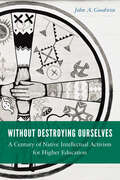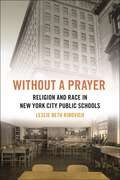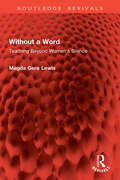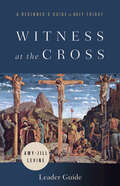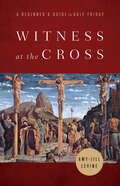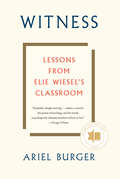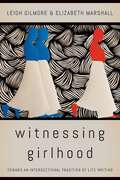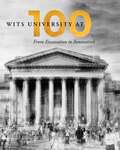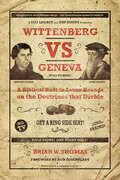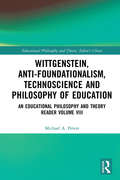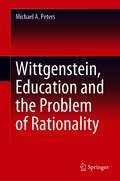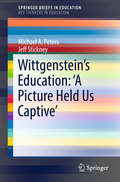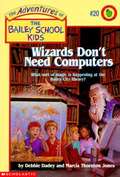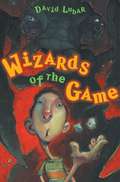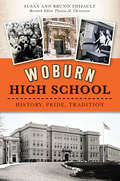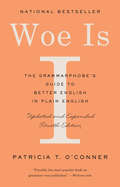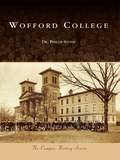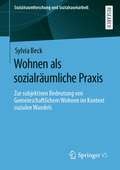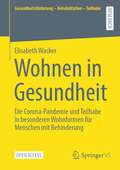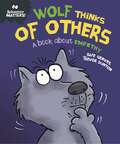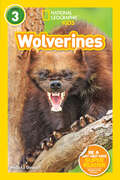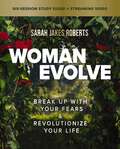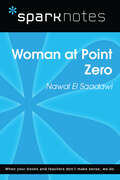- Table View
- List View
Without Destroying Ourselves: A Century of Native Intellectual Activism for Higher Education (Indigenous Education)
by John A. GoodwinWithout Destroying Ourselves is an intellectual history of Native activism seeking greater access to and control of higher education in the twentieth century. John A. Goodwin traces themes of Henry Roe Cloud&’s (Ho-Chunk) vision for Native intellectual leadership and empowerment in the early 1900s to the later missions of tribal colleges and universities (TCUs) and education-based, self-determination movements of the 1960s onward. Vital to Cloud&’s work was the idea of how to build from Native identity and adapt without destroying that identity. As the central themes of the movement for Native control in higher education developed over the course of several decades, a variety of Native activists carried Cloud&’s vision forward. Goodwin explores how Elizabeth Bender Cloud (Ojibwe), D&’Arcy McNickle (Salish Kootenai), Jack Forbes (Powhatan-Renapé, Delaware Lenape), and others built on and contributed to this common thread of Native intellectual activism. Goodwin demonstrates that Native activism for self-determination was never snuffed out by the swing of the federal government&’s pendulum away from tribal governance and toward termination. Moreover, efforts for Native control in education remained a vital aspect of that activism. Without Destroying Ourselves documents this period through the full accreditation of TCUs in the late 1970s and reinforces TCUs&’ continuing relevance in confronting the unique needs and challenges of Native communities today.
Without a Prayer: Religion and Race in New York City Public Schools (North American Religions #24)
by Leslie Beth RibovichReframes religion’s role in twentieth-century American public educationThe processes of secularization and desegregation were among the two most radical transformations of the American public school system in all its history. Many regard the 1962 and 1963 US Supreme Court rulings against school prayer and Bible-reading as the end of religion in public schools. Likewise, the 1954 Brown v. Board of Education case is seen as the dawn of school racial equality. Yet, these two major twentieth-century American educational movements are often perceived as having no bearing on one another.Without a Prayer redefines secularization and desegregation as intrinsically linked. Using New York City as a window into a national story, the volume argues that these rulings failed to successfully remove religion from public schools, because it was worked into the foundation of the public education structure, especially how public schools treated race and moral formation. Moreover, even public schools that were not legally segregated nonetheless remained racially segregated in part because public schools rooted moral lessons in an invented tradition—Judeo-Christianity—and in whiteness.The book illuminates how both secularization and desegregation took the form of inculcating students into white Christian norms as part of their project of shaping them into citizens. Schools and religious and civic constituents worked together to promote programs such as juvenile delinquency prevention, moral and spiritual values curricula, and racial integration advocacy. At the same time, religiously and racially diverse community members drew on, resisted, and reimagined public school morality.Drawing on research from a number of archival repositories, newspaper and legal databases, and visual and material culture, Without a Prayer shows how religion and racial discrimination were woven into the very fabric of public schools, continuing to inform public education’s everyday practices even after the Supreme Court rulings.
Without a Word: Teaching Beyond Women's Silence (Routledge Revivals)
by Magda Gere LewisThe question of women’s silence within academic settings has received a great deal of attention. And much feminist educational scholarship has devoted itself to creating spaces where women’s stories and experiences can be told. Without a Word (first published in 1993) raises the question of women’s silence from a radical new perspective, lending at long last a theoretical basis and sophistication to this important issue.The author considers the subject of silence from a variety of conceptual and practical perspectives. When does silene occur among women? How does it emerge? What are its complex origins? What are its devastating effects? Lewis also discusses the different types of silence: the one which is an expression of a woman’s oppression and the one which is her act of revolt.Actual classroom interactions, student experiences, literary and filmic depictions of women, and her own personal voice are the material from which Lewis crafts her powerful theory. Intended to offer an understanding of the subject which can help feminists and teachers struggling to change the nature and dynamics of classroom experience for all students, Without a Word dramatizes the issue of silence in a way that moves beyond the mere need for women to speak and be heard. This book is a must read for students and researchers of education, feminist studies, women studies, and sociology.
Witness at the Cross Leader Guide: A Beginner's Guide to Holy Friday
by Amy-Jill LevinePlace yourself as a witness of the cross and determine what your own testimony will be! Experience Holy Friday from the perspective of those who watched Jesus die: Mary his mother; the Beloved Disciple from the Gospel of John; Mary Magdalene and the other women from Galilee; the two men, usually identified as thieves, crucified with Jesus; the centurion and the soldiers; Joseph of Arimathea and Nicodemus. Jews and Romans, friends and strangers, the powerful and the powerless, the hopeful and the despairing. The story of Jesus’s death is not something we just read: we think about it, and we experience it; we hear the taunts of the soldiers, the priests, and the passersby even as we hear the famous “seven last words” from the cross.In Witness at the Cross, Amy-Jill Levine shows how the people at the cross each have distinct roles to play. Each Evangelist presents a distinct picture of the death of Jesus. Each portrays different individuals and groups of people at the cross, each offers different images and dialogues, and so from each, we learn how those meanings and messages cross the centuries to any who would come to the cross today. Each Gospel has its own story to tell, all the witnesses have their own memories, and every reader comes away with a new insight. The witnesses at the Crucifixion watch Jesus die, and we watch with them, and we watch them. And we come away transformed.The Leader Guide includes session outline for each group meeting with Scripture, prayer, opening activity, discussion questions, activity, and ending call to action.
Witness at the Cross: A Beginner's Guide to Holy Friday
by Amy-Jill LevinePlace yourself as a witness of the cross and determine what your own testimony will be! Experience Holy Friday from the perspective of those who watched Jesus die: Mary his mother; the Beloved Disciple from the Gospel of John; Mary Magdalene and the other women from Galilee; the two men, usually identified as thieves, crucified with Jesus; the centurion and the soldiers; Joseph of Arimathea and Nicodemus. Jews and Romans, friends and strangers, the powerful and the powerless, the hopeful and the despairing. The story of Jesus’s death is not something we just read: we think about it, and we experience it; we hear the taunts of the soldiers, the priests, and the passersby even as we hear the famous “seven last words” from the cross.In Witness at the Cross, Amy-Jill Levine shows how the people at the cross each have distinct roles to play. Each Evangelist presents a distinct picture of the death of Jesus. Each portrays different individuals and groups of people at the cross, each offers different images and dialogues, and so from each, we learn how those meanings and messages cross the centuries to any who would come to the cross today. Each Gospel has its own story to tell, all the witnesses have their own memories, and every reader comes away with a new insight. The witnesses at the Crucifixion watch Jesus die, and we watch with them, and we watch them. And we come away transformed. Additional components are available for a six-week study include a DVD featuring Dr. Levine and a comprehensive Leader Guide.
Witness: Lessons from Elie Wiesel's Classroom
by Ariel BurgerWINNER OF THE NATIONAL JEWISH BOOK AWARD—BIOGRAPHY Elie Wiesel was a towering presence on the world stage—a Nobel laureate, activist, adviser to world leaders, and the author of more than forty books, including the Oprah’s Book Club selection Night. But when asked, Wiesel always said, “I am a teacher first.” In fact, he taught at Boston University for nearly four decades, and with this book, Ariel Burger—devoted protégé, apprentice, and friend—takes us into the sacred space of Wiesel’s classroom. There, Wiesel challenged his students to explore moral complexity and to resist the dangerous lure of absolutes. In bringing together never-before-recounted moments between Wiesel and his students, Witness serves as a moral education in and of itself—a primer on educating against indifference, on the urgency of memory and individual responsibility, and on the role of literature, music, and art in making the world a more compassionate place. Burger first met Wiesel at age fifteen; he became his student in his twenties, and his teaching assistant in his thirties. In this profoundly thought-provoking and inspiring book, Burger gives us a front-row seat to Wiesel’s remarkable exchanges in and out of the classroom, and chronicles the intimate conversations between these two men over the decades as Burger sought counsel on matters of intellect, spirituality, and faith, while navigating his own personal journey from boyhood to manhood, from student and assistant, to rabbi and, in time, teacher. “Listening to a witness makes you a witness,” said Wiesel. Ariel Burger’s book is an invitation to every reader to become Wiesel’s student, and witness.
Witnessing Girlhood: Toward an Intersectional Tradition of Life Writing
by Elizabeth Marshall Leigh GilmoreWhen more than 150 women testified in 2018 to the sexual abuse inflicted on them by Dr. Larry Nassar when they were young, competitive gymnasts, they exposed and transformed the conditions that shielded their violation, including the testimonial disadvantages that cluster at the site of gender, youth, and race. In Witnessing Girlhood, Leigh Gilmore and Elizabeth Marshall argue that they also joined a long tradition of autobiographical writing led by women of color in which adults use the figure and narrative of child witness to expose harm and seek justice. Witnessing Girlhood charts a history of how women use life narrative to transform conditions of suffering, silencing, and injustice into accounts that enjoin ethical response. Drawing on a deep and diverse archive of self-representational forms—slave narratives, testimonio, memoir, comics, and picture books—Gilmore and Marshall attend to how authors return to a narrative of traumatized and silenced girlhood and the figure of the child witness in order to offer public testimony. Emerging within these accounts are key scenes and figures that link a range of texts and forms from the mid–nineteenth century to the contemporary period. Gilmore and Marshall offer a genealogy of the reverberations across timelines, self-representational acts, and jurisdictions of the child witness in life writing. Reconstructing these historical and theoretical trajectories restores an intersectional testimonial history of writing by women of color about sexual and racist violence to the center of life writing and, in so doing, furthers our capacity to engage ethically with representations of vulnerability, childhood, and collective witness.
Wits University at 100: From Excavation to Innovation
by University of WitwatersrandMaps the university’s current and future vision as it marks its centenary in 2022The University of the Witwatersrand occupies a special place in the hearts and minds of South Africans. It is a leading university renowned for its commitment to academic excellence, social justice and the advancement of the public good. Its history is inextricably linked with the development of Johannesburg, with mining and economic development, and with political and social activism across the country. Wits University at 100: From Excavation to Innovation captures important moments of Wits’ story in celebration of the university’s centenary in 2022. It explores Wits’ origins, the space and place that it occupies in society, and its transformation as it prepares the ground for the next century. From its humble beginnings as a mining college in Johannesburg to its current position as a flourishing and inclusive university, Wits University at 100 is a story of innovation driven from the global South. In text and image, Wits is presented as a dynamic institution that thrives because of its people, many of whom, in one way or another, have shifted the world. The experiences, achievements and insights of past and present ‘Witsies’ come alive in this glossy, full-color book that maps the university’s vision for the future.
Wittenberg Vs. Geneva: A Biblical Bout in Seven Rounds on the Doctrines that Divide
by Brian William ThomasWhat are the differences between Lutherans and Calvinists, and do they really matter? In Wittenberg vs. Geneva, Brian Thomas provides a biblical defense of the key doctrines that have divided the Lutheran and Reformed traditions for nearly five centuries.It is especially written to help those who may have an interest in the Lutheran church, but are concerned that her stance on doctrines like predestination or the sacraments may not have biblical support. To get to the heart of the matter, Pastor Thomas focuses solely upon those crucial scriptural texts that have led Lutheran and Reformed scholars down different paths to disparate conclusions as he spars with popular Calvinist theologians from the past and the present.
Wittgenstein, Anti-foundationalism, Technoscience and Philosophy of Education: An Educational Philosophy and Theory Reader Volume VIII (Educational Philosophy and Theory: Editor’s Choice)
by Michael A. PetersThis book is a collection of essays motivated by a "cultural" and biographical reading of Wittgenstein. It includes some new essays and some that were originally published in Educational Philosophy and Theory. The book focuses on the concept of “technoscience”, and the relevance of Wittgenstein’s work for philosophy of technology which amplifies Lyotard’s reading and provides a critique of education as an increasingly technology-led enterprise. It includes a distinctive view on the ethics of reading Wittgenstein and the ethics of suicide that shaped him. It also examines the reception and engagement with Wittgenstein’s work in French philosophy with a chapter on post-analytic philosophy of education as a choice between Richard Rorty and Jean-François Lyotard. Peters examines Wittgenstein’s academic life at Cambridge University and his involvement as a student and faculty member in the Moral Sciences Club. Finally, the book provides an understanding of Wittgensteinian styles of reasoning and the concept of worldview. Is it possible to escape the picture that holds us captive? This constitutes a challenging introduction to Wittgenstein’s work for academics, researchers and postgraduate students in the fields of education, technology and philosophy.
Wittgenstein, Education and the Problem of Rationality
by Michael A. PetersThis book develops an argument for a historicist and non-foundationalist notion of rationality based on an interpretation of Wittgenstein of the Philosophical Investigations and On Certainty. The book examines two notions of rationality—a universal versus a constitutive conception – and their significance for educational theory. The former advanced by analytic philosophy of education as a form of conceptual analysis is based on a mistaken reading of Wittgenstein. Analytic philosophy of education used a reading of Wittgenstein’s philosophy of language to set up and justify an absolute, universal and ahistorical notion of rationality. By contrast, the book examines the underlying influence of the later Wittgenstein on the historicist turn in philosophy of science as a basis for a non-foundationalist and constitutive notion of rationality which is both historical and cultural, and remains consistent with wider developments in philosophy, hermeneutics and social theory. This book aims to understand the philosophical motivation behind this view, to examine its intellectual underpinnings and to substitute this universal conception of rationality by reference to a Hegelian interpretation of the later Wittgenstein that emphasizes his status as an anti-foundational thinker.
Wittgenstein’s Education: 'A Picture Held Us Captive’
by Michael A. Peters Jeff StickneyDedicated to educators who are not philosophy specialists, this book offers an overview of the connections between Wittgenstein’s later philosophy and his own training and practice as an educator. Arguing for the centrality of education to Wittgenstein’s life and works, the authors resist any reduction of Wittgenstein’s philosophy to remarks on pedagogy while addressing the current controversy surrounding the role of training in the enculturation process. Significant events in his education and life are examined as the background for successful interpretation, without lending biographical details explanatory force. The book discusses the importance of Wittgenstein’s training and dismissal as an elementary teacher (1920-26) in light of his later, frequent use (1930s-40s) of many ‘scenes of instruction’ in his Cambridge lectures and notebooks. These depictions culminated in his now famous Philosophical Investigations -- a counter to his earlier philosophy in the Tractatus. Wittgenstein came to distinguish between empirical inquiries into how education, language or mathematics might ideally work, from grammatical studies of how we learn on the rough ground to normatively go-on as others do – often without explicit rules and with considerable degrees of ambiguity, for instance, in implementing new guidelines during a curriculum reform or in evaluating teachers. The book argues that Wittgenstein’s reflections on education -- spanning from mathematics training to the acquisition of language and cultivation of aesthetic appreciation -- are of central significance to both the man and his pedagogical style of philosophy.
Wizards Don't Need Computers (The Adventures of the Bailey School kids #20)
by Debbie Dadey Marcia Thornton JonesThere are some pretty weird grownups living in Bailey City. But could the new librarian who has a long white beard and a magic wand really be Merlin, the great wizard from medieval times? The Bailey School Kids are going to find out! "I just realized that Mr. Merle's name sounds like Merlin," said Liza. Melody's eyes were big. "And his fish's name is Arthur, as in King Arthur!" "Maybe Mr. Merle is Merlin," Howie said. Liza and Melody gulped, but Eddie just laughed. "Wizards use magic to get whatever they want. Theydon't have to work in libraries shelving books. And they definitely don't need computers!"
Wizards Don't Wear Graduation Gowns (The Adventures of the Bailey School Kids #45)
by Debbie Dadey Marcia Thornton JonesFrom the book jacket: There are some pretty weird grownups living in Bailey City. But could the new assistant principal really be a wizard who wants to turn everyone at graduation intoan animal? The Bailey School Kids are going to find out! "Howie is not right," Eddie said. "A person cannot be turned into a bird and an assistant principal cannot be a wizard, especially when she's a girl. Mrs. Jhick is not a wizard and she can't make anybody do anything." "Oh, yeah?" Howie asked. "Then tell Melody she's a nincompoop!" "Gladly," Eddie said with a smirk. He turned to Melody. He opened his mouth. Nothing came out."See?" Howie said. "Mrs. Jhick cast a spell on you and now you can't insult your friends." Eddie put his hands on his cheeks. "This is horrible," Eddie gasped. "It's terrible. It's the end of the world. That wizette must be stopped!" RL3 007-010
Wizards of the Game
by David LubarEighth-grader Mercer, whose passion is the fantasy role-playing game Wizards of the Warrior World, hopes to use a fund-raiser to bring a gaming convention to his middle school.
Woburn High School: History, Pride, Tradition (Landmarks)
by Susan Ann Thifault Theresa M. ChristersonWoburn High School has instilled the importance of education in generations of students for over 160 years. The school opened its doors in 1852 with thirty-four students in a leased room at the Knight Building on Main Street. Increasing enrollment and curriculum requirements necessitated the building of a larger school on Main Street in 1854 and again in 1906 at the Dow Farm property on Montvale Avenue. Woburn's reputation as a leading leather manufacturer during the Civil War inspired the Tanner nickname, bull mascot and school motto: "Tanner Pride." With the leadership of thirteen principals throughout its history, over thirty-two thousand students have graduated from this school. Today, more than half the faculty are returning alumni, and generations of Woburn families continue to send their children to this school. Join author Susan Thifault as she explores a history of pride and tradition at Woburn High School.
Woe Is I: The Grammarphobe's Guide to Better English in Plain English (Fourth Edition)
by Patricia T. O'ConnerA revised and updated edition of the iconic grammar guide for the 21st century.In this expanded and updated edition of Woe Is I, former editor at The New York Times Book Review Patricia T. O'Conner unties the knottiest grammar tangles with the same insight and humor that have charmed and enlightened readers of previous editions for years. With fresh insights into the rights, wrongs, and maybes of English grammar and usage, O'Conner offers in Woe Is I down-to-earth explanations and plain-English solutions to the language mysteries that bedevil all of us."Books about English grammar and usage are... never content with the status quo," O'Conner writes. "That's because English is not a stay-put language. It's always changing--expanding here, shrinking there, trying on new things, casting off old ones... Time doesn't stand still and neither does language."In this fourth edition, O'Conner explains how the usage of an array of words has evolved. For example, the once-shunned "they," "them," and "their" for an unknown somebody is now acceptable. And the battle between "who" and "whom" has just about been won, O'Conner says (hint: It wasn't by "whom"). Then there's the use of "taller than me" in simple comparisons, instead of the ramrod-stiff "taller than I." "May" and "might," "use to" and "used to," abbreviations that use periods and those that don't, and the evolving definition of "unique" are all explained here by O'Conner. The result is an engaging, up-to-date and jargon-free guide to every reader's questions about grammar, style, and usage for the 21st century.
Wofford College (Campus History)
by Dr Phillip StoneFounded with a bequest of $100,000 from the Reverend Benjamin Wofford, Wofford College opened in Spartanburg, South Carolina, in August 1854. More than 150 years later, the college remains on its original campus, a national arboretum. Five of its earliest six buildings are in daily use. Throughout its history, Wofford has maintained its connection with South Carolina Methodism and has benefited from the support of its alumni. Many of its 15,500 living alumni maintain strong ties to the college and to each other. The awarding of a chapter of Phi Beta Kappa in 1941 recognized the college's dedication to the liberal arts and its commitment to academic excellence. Though the student body has grown from around 500 before World War II to nearly 1,500 in 2010, Wofford retains its commitment to developing relationships between students and professors.
Wohnen als sozialräumliche Praxis: Zur subjektiven Bedeutung von Gemeinschaftlichem Wohnen im Kontext sozialen Wandels (Sozialraumforschung und Sozialraumarbeit #21)
by Sylvia BeckDas Thema Wohnen prägt aktuell die Debatten in Politik und Stadtplanung. Seine Bedeutung im alltäglichen Lebenszusammenhang bleibt dabei jedoch weitgehend undiskutiert und Soziale Arbeit als Profession erstaunlich unbeteiligt. Vermeintlich losgelöst davon erfahren Gemeinschaftliche Wohnprojekte wachsenden Zuspruch, werden angesichts gesellschaftlicher Veränderungen positiv konnotiert und mittlerweile auch politisch protegiert. Wie und worüber Menschen hier Zugewinne für ihre Lebensgestaltungen erfahren, bleibt wissenschaftlich bislang unbeleuchtet. Das Buch setzt an dieser Lücke an und arbeitet Bewältigungs- und Gestaltungsleistungen der Bewohner*innen angesichts spätmoderner Entgrenzungen, Selbstzuständigkeiten und Verunsicherungen heraus. Als subjektorientierte Wohnforschung verfolgt sie in einem praxeologischen und sozialräumlichen Grundverständnis von Wohnen eine biographische Perspektive. In den Blick genommen wird Alltagshandeln im Wohnen unter den sozialen, räumlichen und strukturellen Gegebenheiten der Wohnprojekte. Relevant zeigen sich hierbei neben einer Sozialen Wohnraumversorgung und Gewinnen einer kollektiven Alltagsgestaltung auch ermöglichte Aneignungsprozesse, die u.a. Partizipationsinteressen stärken können
Wohnen in Gesundheit: Die Corona-Pandemie und Teilhabe in besonderen Wohnformen für Menschen mit Behinderung (Gesundheitsförderung - Rehabilitation - Teilhabe)
by Elisabeth WackerIn diesem Open-Access-Buch wird die Coronapandemie in besonderen Wohneinrichtungen der Eingliederungshilfe im sozialwissenschaftlichen Blick erfasst. Die Lagebeschreibung spiegelt verschiedene Perspektiven: die Einschätzungen von Menschen mit Beeinträchtigungen, Leitungsverantwortlichen, Fachpersonal und Angehörigen. Die Daten wurden bundesweit während der Lockdown-Phasen in einer qualitativen Feldstudie erhoben. Die Analyse folgt den Rahmungen der ICF (International Classification of Functioning, Disability and Health der WHO) und der Behindertenrechtskonvention der Vereinten Nationen (UN-BRK). Faktenbasiert zeigen sich fehlende Brücken zwischen den Handlungsfeldern Gesundheit und Soziales. Im demografischen Wandel bleibt Wohnen in Gesundheit über die Pandemie hinaus ein drängendes Zukunftsthema. Die WoGe-Studie bietet Ansätze zur konstruktiven Auseinandersetzung mit ungleichen Versorgungschancen in Gleichstellung, Teilhabe und Gesundheitssorge. Durch den Blick hinter die Kulissen öffnen sich Lernoptionen und zeigen sich Handlungsnotwendigkeiten bei Risiken der Fremdbestimmung, erheblichen Personalengpässen und anhaltendem Kräfteverschleiß. Auch Bedarfe an mehr Gesundheitsbewusstsein und Präventionsorientierung werden aufgezeigt.
Wolf Girls At Vassar: Lesbian and Gay Experiences 1930-1990
by Anne MaccayA collection of reflections by lesbian and gay Vassar graduates recalls the struggles of homosexuals living under a cloud of silence and repression for the past sixty years. Reprint.
Wolf Thinks of Others - A book about empathy (Behaviour Matters)
by Sue GravesWolf Thinks of Others offers a gentle introduction to the concept of empathy and thinking of others for young children.This funny, charming story is the perfect way to introduce young children to the concept of empathy and thinking about other people. Also included are suggestions for activities and ideas to talk through together to help children understand their behaviour.Wolf never thinks about other people. He doesn't share toys, and he doesn't care when Hippo is hurt. But when his friends get cross with him, Wolf is upset. Can he start thinking of others?The Behaviour Matters series of picture books provide a gentle means of discussing emotions, boosting self-esteem and reinforcing good behaviour. Supports the Personal, Social and Emotional Development Area of Learning in the Early Years Foundation Stage, and is also suitable for use with children in KS1 and can be used to discuss values. Suitable for children under 5.
Wolverines (National Geographic Kids Readers)
by Melissa StewartSuperhero and comic book force? Sure, but also a real-life animal! Find out in this Level 3 Reader how fierce wolverines, who are expert survivors, can be even more fantastic than those in movies and graphic novels.Journey through harsh cold and rugged mountain ranges to see how wolverines take down prey, raise their young, and live in one of the world's harshest environments. Learn about how their bodies adapt for survival, and about the animal's challenges in a warming world.National Geographic Readers' combination of expert-vetted text, along with brilliant images and a fun approach to reading has proved to be a winning formula with kids, parents and educators. Level 3 text provides accessible, yet wide-ranging, information for fluent readers. Each reader includes text written by an experienced, skilled children's books author, a photo glossary, and interactive features in which kids get to reinforce what they've learned in the book.
Woman Evolve Bible Study Guide plus Streaming Video: Break Up with Your Fears and Revolutionize Your Life
by Sarah Jakes RobertsLet the Living Water Change You From the Inside Out.Whether you're trying to recover from a setback, break free from an addiction, or bring forth good fruit despite the forbidden fruit you were exposed to, God has a redeeming plan for you—just like He did for Eve. He wants to bless you and bless people through you. You are a beautiful, vast, ornate demonstration of God's thoughts and hope for humanity.Join Sarah Jakes Roberts for this six-session video Bible study (streaming code included) exposing the truth that you were born to bring light to the darkness, a revolution of faith to the next generation, and a smile in the wild! When fear tries to creep in and anxiety fights to seep in, you'll remember two words, and know your command into freedom: Woman, Evolve!This study guide has everything you need for a full Bible study experience, including:The study guide itself—with discussion and reflection questions, video notes, and a leader's guide.An individual access code to stream all video sessions online. (You don&’t need to buy a DVD!)Sessions and video run times:Drop Those Fig Leaves (21:00) Damage Control (23:00) What Are We Doing Today? (20:00) You Need a Trim (21:00) No Turning Back (25:00) Don&’t Do It Alone (28:00)Streaming video access code included. Access code subject to expiration after 12/31/2027. Code may be redeemed only by the recipient of this package. Code may not be transferred or sold separately from this package. Internet connection required. Void where prohibited, taxed, or restricted by law. Additional offer details inside.
Woman at Point Zero (SparkNotes Literature Guide Series)
by SparkNotesWoman at Point Zero (SparkNotes Literature Guide) by Nawal El Saadawi Making the reading experience fun! Created by Harvard students for students everywhere, SparkNotes is a new breed of study guide: smarter, better, faster. Geared to what today's students need to know, SparkNotes provides: *Chapter-by-chapter analysis *Explanations of key themes, motifs, and symbols *A review quiz and essay topicsLively and accessible, these guides are perfect for late-night studying and writing papers
